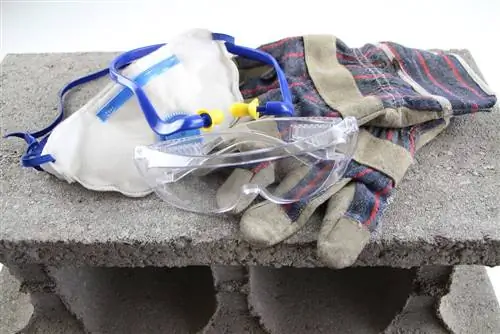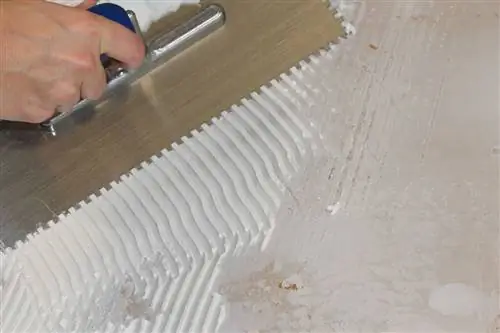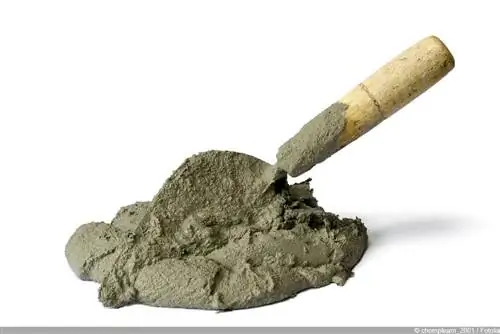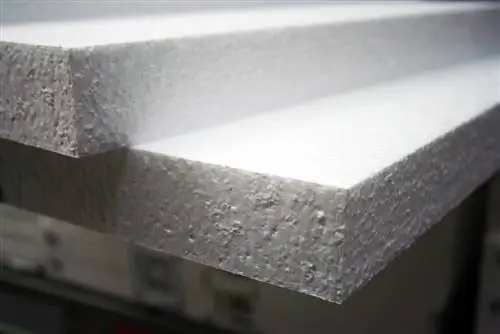- Author admin [email protected].
- Public 2023-12-17 03:39.
- Last modified 2025-01-24 12:45.
Tile adhesive ensures a strong hold of the tiles on the wall. It is even more difficult to remove if tile adhesive residue is accidentally found on the front of the tiles. However, it is possible if a few factors are taken into account and the right approach is followed. We give practical tips on how it can work.
Security
When tile adhesive has hardened, it is not easy to completely remove all residue. Both the mechanical approach and the use of chemical agents are difficult and involve certain risks. It is therefore important to take appropriate protective measures.
These include:
Safety glasses
When the tile adhesive is removed mechanically, individual pieces may come off. Safety glasses should be worn so that these do not literally get in the eye.
Gloves
Contact with solvents used can severely irritate the skin. It is therefore important to wear rubber gloves.
Possibly respiratory protection
During mechanical removal, a lot of dust can develop, which makes respiratory protection useful. When chemical agents are used, the vapors can have an irritating effect. In this case, a respiratory mask must be worn and the room must be well ventilated.

Possible aids
If the glue has not yet hardened, water, dishwashing liquid and a rough, hard sponge are often sufficient. However, in other cases, more tools are needed.
The following utensils, among others, are required for mechanical removal:
- rough sponge
- Steel wool or wire brush
- Plane, spatula, ceramic hob scraper
- Screwdriver or chisel and hammer
Depending on the type of tile adhesive, the following agents can be used for chemical removal:
- Stripper for emulsion paints
- Cement film remover
- Hydrochloric acid-water solution
Chemically remove tile adhesive
The use of chemical solvents is a comparatively simple and safe way for the tiles to remove adhesive residue. However, eyes, skin and respiratory tract need urgent protection. In addition, as mentioned, the room must be well ventilated to keep the exposure to fumes as low as possible.
If these security measures are guaranteed, the following procedure will be followed:
- A special paint stripper for emulsion paints is applied specifically to the adhesive residue and allowed to take effect according to the manufacturer's instructions. The adhesive is then processed with a rough sponge, steel wool or a brush.
- If the paint stripper does not remove everything, the process can be repeated. If there is no improvement, cement film remover can be used. First, however, all residues of the paint stripper should be washed off thoroughly and with plenty of water.
- The cement film remover is then applied to the tiles, allowed to take effect and then the tile adhesive residue is removed by hand. If this remedy has no effect, a mixture of hydrochloric acid and water can be used.
30 percent hydrochloric acid is chosen to use the acid mixture. Three parts of the acid are added to one part of water. The acid is added to the water and never the water to the acid. Because pouring water into the acid can cause severe splashing. Mixing should be done outdoors. It is also very important to comprehensively protect skin, eyes and respiratory tract from contact and fumes. The application process does not differ from the process already described.
Removing tile adhesive mechanically
In many cases, chemical removal will not be completely sufficient to completely remove the tile adhesive from the front of the tiles. The chance of success depends on the hardening time of the adhesive. The longer it has had to dry, the harder and more stubborn it is. If the chemical agents do not have the desired effect, removal can be done mechanically. This works best on tiles with a very smooth surface. To avoid damage to the tiles, the respective aids should first be tested on an inconspicuous area or on leftover tiles.

The residues can now be removed piece by piece using the tools mentioned above, such as steel wool or spatula. It is also possible to use a sander. Removal usually requires a lot of effort and patience. There is also the risk that scratches or streaks will appear on the tiles or that they will crack. If in doubt, a specialist should be commissioned to remove the adhesive residue.
Time
The quicker the glue is removed, the easier it is to clean. Fresh tile adhesive residues have not yet completely hardened and can usually be removed with a hard sponge, dishwashing liquid and water or the appropriate solvent. After laying new tiles, you should immediately start removing the adhesive residue. It's a good idea to go from row to row and remove any residue while laying. This avoids the problem that the tiles cannot be walked on while drying.
Tip:
In order to identify the adhesive residue and remove it thoroughly, the tiles should be checked under different lighting conditions. To do this, it is helpful to use a flashlight and illuminate the tiles from different angles. Even small residues can be noticed quickly and easily.






